Supply Chain Management Analysis: Toyota Motor Corporation Report
VerifiedAdded on 2020/02/05
|11
|3504
|557
Report
AI Summary
This report provides a comprehensive analysis of Toyota Motor Corporation's supply chain management. It begins with an executive summary outlining Toyota's global presence and supply chain strategies based on the Toyota Production System (TPS). The report then delves into the application of technology and information systems to mitigate the bullwhip effect, a phenomenon causing inventory fluctuations. It recommends solutions like Electronic Data Interchange (EDI), Vendor Managed Inventory, Computer-Aided Ordering, and Point of Sale systems. Furthermore, the report examines the use and benefits of Customer Relationship Management (CRM) in enhancing customer service, time management, and communication. Finally, the report discusses the impact of centralization versus decentralization on supply chain decision-making. The analysis highlights the importance of technology, CRM, and strategic decision-making in optimizing Toyota's supply chain for efficiency and customer satisfaction.

Individual assignment
Table of Contents
Supply chain case study...................................................................................................................3
1
Table of Contents
Supply chain case study...................................................................................................................3
1
Paraphrase This Document
Need a fresh take? Get an instant paraphrase of this document with our AI Paraphraser
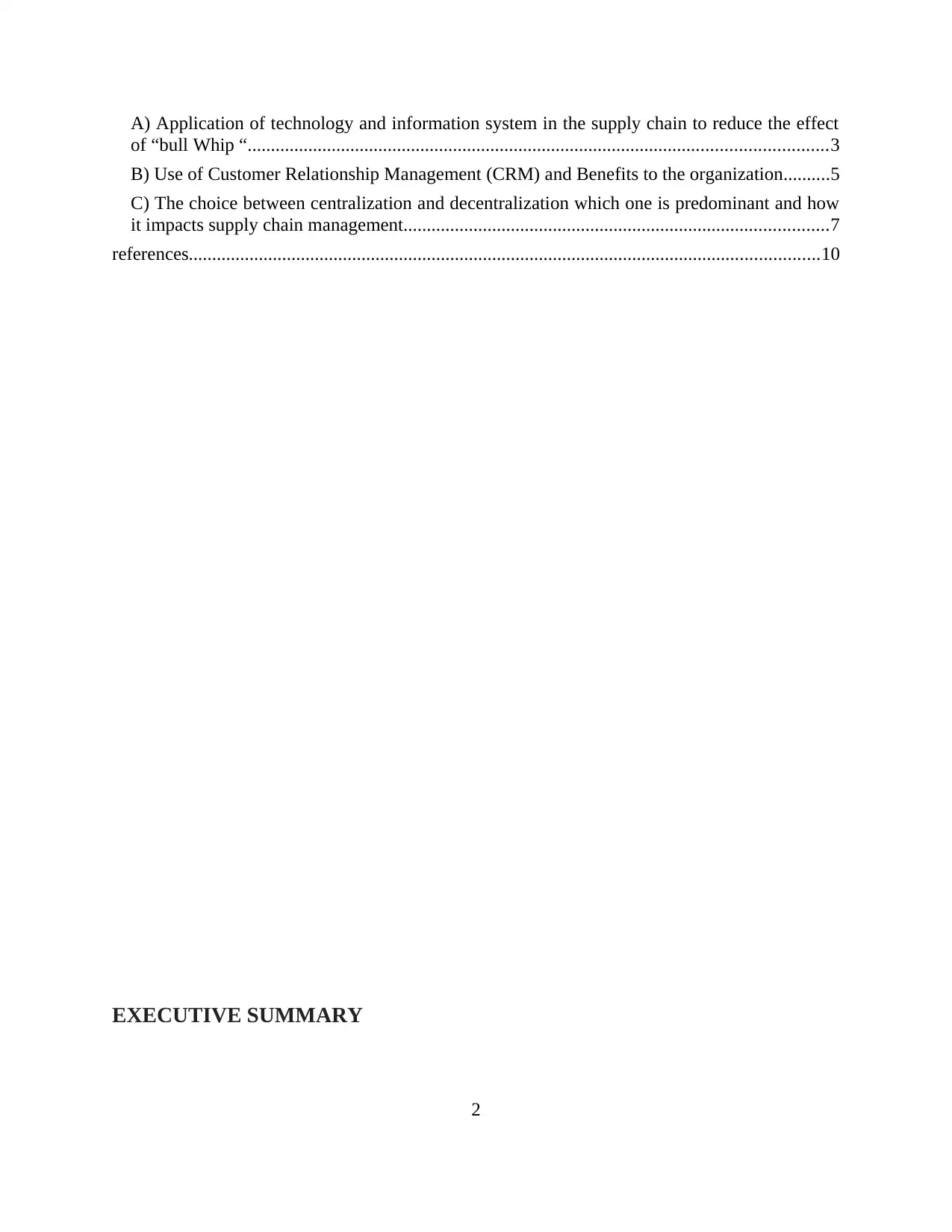
A) Application of technology and information system in the supply chain to reduce the effect
of “bull Whip “............................................................................................................................3
B) Use of Customer Relationship Management (CRM) and Benefits to the organization..........5
C) The choice between centralization and decentralization which one is predominant and how
it impacts supply chain management...........................................................................................7
references.......................................................................................................................................10
EXECUTIVE SUMMARY
2
of “bull Whip “............................................................................................................................3
B) Use of Customer Relationship Management (CRM) and Benefits to the organization..........5
C) The choice between centralization and decentralization which one is predominant and how
it impacts supply chain management...........................................................................................7
references.......................................................................................................................................10
EXECUTIVE SUMMARY
2
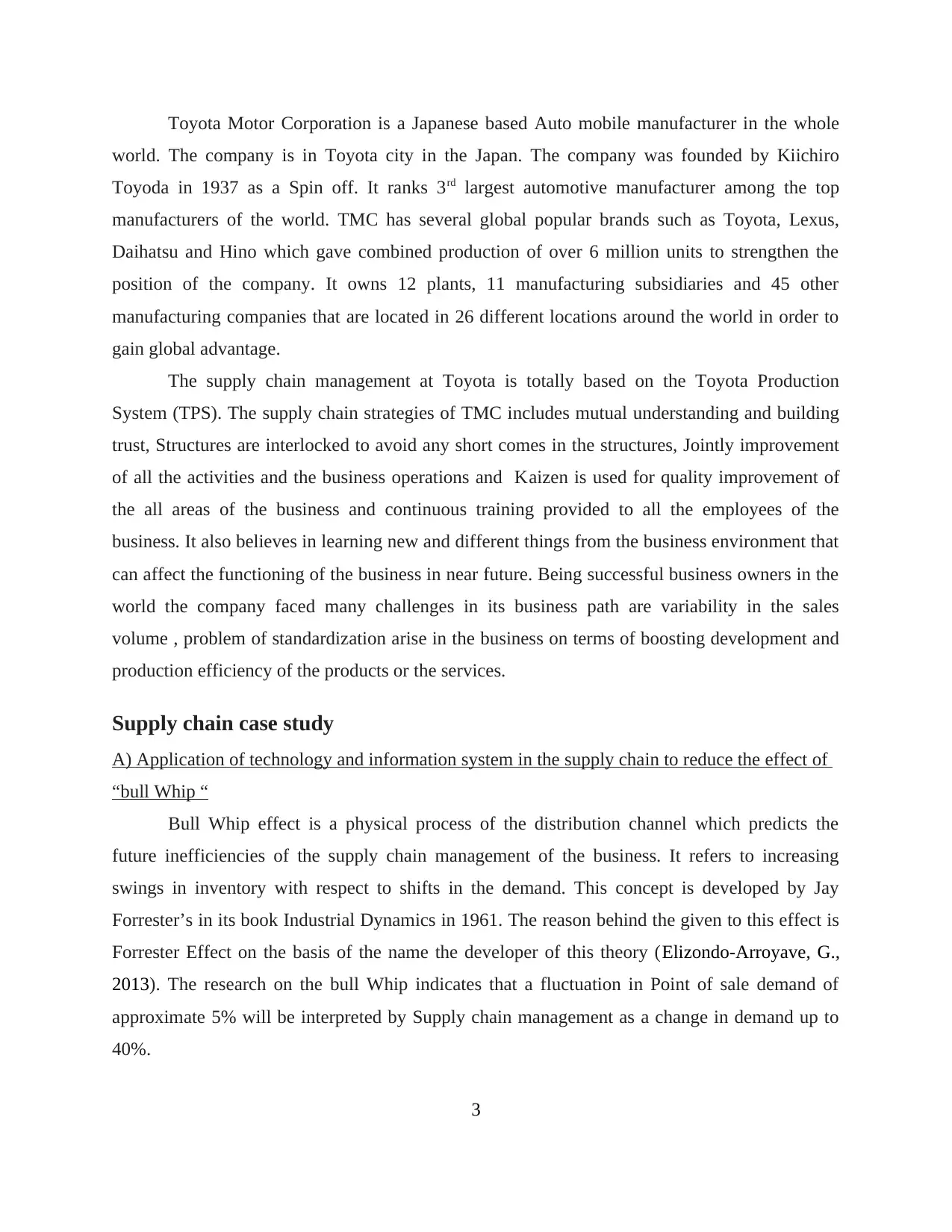
Toyota Motor Corporation is a Japanese based Auto mobile manufacturer in the whole
world. The company is in Toyota city in the Japan. The company was founded by Kiichiro
Toyoda in 1937 as a Spin off. It ranks 3rd largest automotive manufacturer among the top
manufacturers of the world. TMC has several global popular brands such as Toyota, Lexus,
Daihatsu and Hino which gave combined production of over 6 million units to strengthen the
position of the company. It owns 12 plants, 11 manufacturing subsidiaries and 45 other
manufacturing companies that are located in 26 different locations around the world in order to
gain global advantage.
The supply chain management at Toyota is totally based on the Toyota Production
System (TPS). The supply chain strategies of TMC includes mutual understanding and building
trust, Structures are interlocked to avoid any short comes in the structures, Jointly improvement
of all the activities and the business operations and Kaizen is used for quality improvement of
the all areas of the business and continuous training provided to all the employees of the
business. It also believes in learning new and different things from the business environment that
can affect the functioning of the business in near future. Being successful business owners in the
world the company faced many challenges in its business path are variability in the sales
volume , problem of standardization arise in the business on terms of boosting development and
production efficiency of the products or the services.
Supply chain case study
A) Application of technology and information system in the supply chain to reduce the effect of
“bull Whip “
Bull Whip effect is a physical process of the distribution channel which predicts the
future inefficiencies of the supply chain management of the business. It refers to increasing
swings in inventory with respect to shifts in the demand. This concept is developed by Jay
Forrester’s in its book Industrial Dynamics in 1961. The reason behind the given to this effect is
Forrester Effect on the basis of the name the developer of this theory (Elizondo-Arroyave, G.,
2013). The research on the bull Whip indicates that a fluctuation in Point of sale demand of
approximate 5% will be interpreted by Supply chain management as a change in demand up to
40%.
3
world. The company is in Toyota city in the Japan. The company was founded by Kiichiro
Toyoda in 1937 as a Spin off. It ranks 3rd largest automotive manufacturer among the top
manufacturers of the world. TMC has several global popular brands such as Toyota, Lexus,
Daihatsu and Hino which gave combined production of over 6 million units to strengthen the
position of the company. It owns 12 plants, 11 manufacturing subsidiaries and 45 other
manufacturing companies that are located in 26 different locations around the world in order to
gain global advantage.
The supply chain management at Toyota is totally based on the Toyota Production
System (TPS). The supply chain strategies of TMC includes mutual understanding and building
trust, Structures are interlocked to avoid any short comes in the structures, Jointly improvement
of all the activities and the business operations and Kaizen is used for quality improvement of
the all areas of the business and continuous training provided to all the employees of the
business. It also believes in learning new and different things from the business environment that
can affect the functioning of the business in near future. Being successful business owners in the
world the company faced many challenges in its business path are variability in the sales
volume , problem of standardization arise in the business on terms of boosting development and
production efficiency of the products or the services.
Supply chain case study
A) Application of technology and information system in the supply chain to reduce the effect of
“bull Whip “
Bull Whip effect is a physical process of the distribution channel which predicts the
future inefficiencies of the supply chain management of the business. It refers to increasing
swings in inventory with respect to shifts in the demand. This concept is developed by Jay
Forrester’s in its book Industrial Dynamics in 1961. The reason behind the given to this effect is
Forrester Effect on the basis of the name the developer of this theory (Elizondo-Arroyave, G.,
2013). The research on the bull Whip indicates that a fluctuation in Point of sale demand of
approximate 5% will be interpreted by Supply chain management as a change in demand up to
40%.
3
You're viewing a preview
Unlock full access by subscribing today!
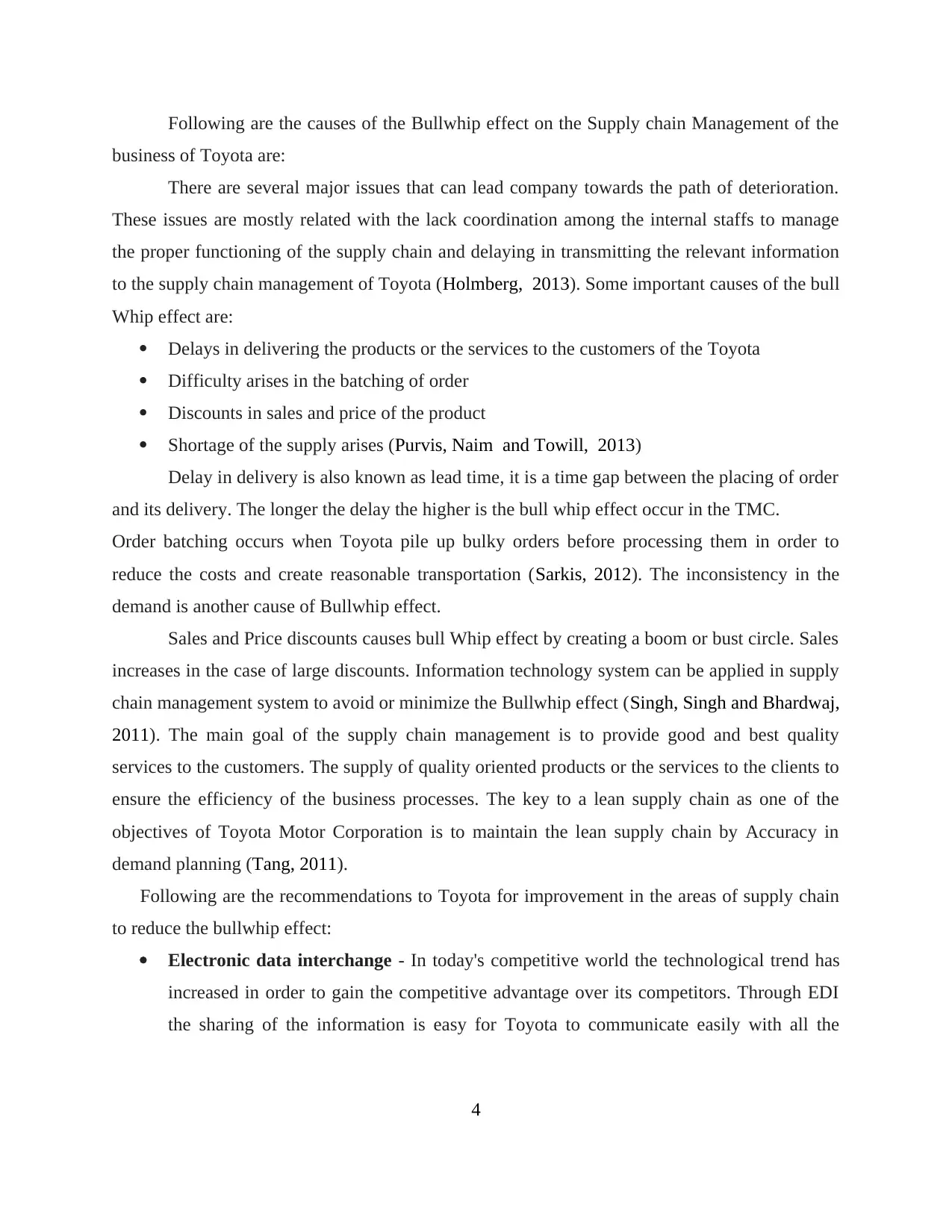
Following are the causes of the Bullwhip effect on the Supply chain Management of the
business of Toyota are:
There are several major issues that can lead company towards the path of deterioration.
These issues are mostly related with the lack coordination among the internal staffs to manage
the proper functioning of the supply chain and delaying in transmitting the relevant information
to the supply chain management of Toyota (Holmberg, 2013). Some important causes of the bull
Whip effect are:
Delays in delivering the products or the services to the customers of the Toyota
Difficulty arises in the batching of order
Discounts in sales and price of the product
Shortage of the supply arises (Purvis, Naim and Towill, 2013)
Delay in delivery is also known as lead time, it is a time gap between the placing of order
and its delivery. The longer the delay the higher is the bull whip effect occur in the TMC.
Order batching occurs when Toyota pile up bulky orders before processing them in order to
reduce the costs and create reasonable transportation (Sarkis, 2012). The inconsistency in the
demand is another cause of Bullwhip effect.
Sales and Price discounts causes bull Whip effect by creating a boom or bust circle. Sales
increases in the case of large discounts. Information technology system can be applied in supply
chain management system to avoid or minimize the Bullwhip effect (Singh, Singh and Bhardwaj,
2011). The main goal of the supply chain management is to provide good and best quality
services to the customers. The supply of quality oriented products or the services to the clients to
ensure the efficiency of the business processes. The key to a lean supply chain as one of the
objectives of Toyota Motor Corporation is to maintain the lean supply chain by Accuracy in
demand planning (Tang, 2011).
Following are the recommendations to Toyota for improvement in the areas of supply chain
to reduce the bullwhip effect:
Electronic data interchange - In today's competitive world the technological trend has
increased in order to gain the competitive advantage over its competitors. Through EDI
the sharing of the information is easy for Toyota to communicate easily with all the
4
business of Toyota are:
There are several major issues that can lead company towards the path of deterioration.
These issues are mostly related with the lack coordination among the internal staffs to manage
the proper functioning of the supply chain and delaying in transmitting the relevant information
to the supply chain management of Toyota (Holmberg, 2013). Some important causes of the bull
Whip effect are:
Delays in delivering the products or the services to the customers of the Toyota
Difficulty arises in the batching of order
Discounts in sales and price of the product
Shortage of the supply arises (Purvis, Naim and Towill, 2013)
Delay in delivery is also known as lead time, it is a time gap between the placing of order
and its delivery. The longer the delay the higher is the bull whip effect occur in the TMC.
Order batching occurs when Toyota pile up bulky orders before processing them in order to
reduce the costs and create reasonable transportation (Sarkis, 2012). The inconsistency in the
demand is another cause of Bullwhip effect.
Sales and Price discounts causes bull Whip effect by creating a boom or bust circle. Sales
increases in the case of large discounts. Information technology system can be applied in supply
chain management system to avoid or minimize the Bullwhip effect (Singh, Singh and Bhardwaj,
2011). The main goal of the supply chain management is to provide good and best quality
services to the customers. The supply of quality oriented products or the services to the clients to
ensure the efficiency of the business processes. The key to a lean supply chain as one of the
objectives of Toyota Motor Corporation is to maintain the lean supply chain by Accuracy in
demand planning (Tang, 2011).
Following are the recommendations to Toyota for improvement in the areas of supply chain
to reduce the bullwhip effect:
Electronic data interchange - In today's competitive world the technological trend has
increased in order to gain the competitive advantage over its competitors. Through EDI
the sharing of the information is easy for Toyota to communicate easily with all the
4
Paraphrase This Document
Need a fresh take? Get an instant paraphrase of this document with our AI Paraphraser
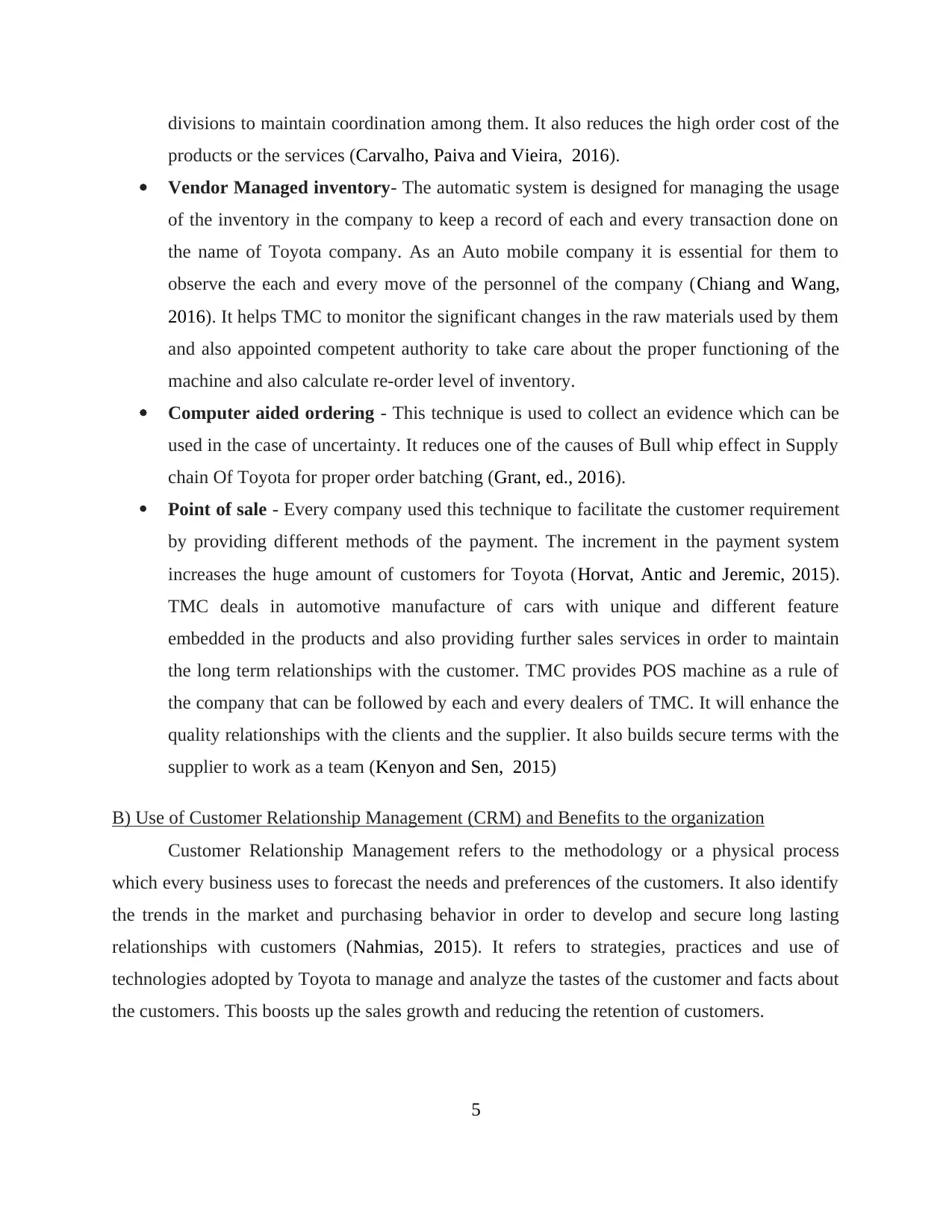
divisions to maintain coordination among them. It also reduces the high order cost of the
products or the services (Carvalho, Paiva and Vieira, 2016).
Vendor Managed inventory- The automatic system is designed for managing the usage
of the inventory in the company to keep a record of each and every transaction done on
the name of Toyota company. As an Auto mobile company it is essential for them to
observe the each and every move of the personnel of the company (Chiang and Wang,
2016). It helps TMC to monitor the significant changes in the raw materials used by them
and also appointed competent authority to take care about the proper functioning of the
machine and also calculate re-order level of inventory.
Computer aided ordering - This technique is used to collect an evidence which can be
used in the case of uncertainty. It reduces one of the causes of Bull whip effect in Supply
chain Of Toyota for proper order batching (Grant, ed., 2016).
Point of sale - Every company used this technique to facilitate the customer requirement
by providing different methods of the payment. The increment in the payment system
increases the huge amount of customers for Toyota (Horvat, Antic and Jeremic, 2015).
TMC deals in automotive manufacture of cars with unique and different feature
embedded in the products and also providing further sales services in order to maintain
the long term relationships with the customer. TMC provides POS machine as a rule of
the company that can be followed by each and every dealers of TMC. It will enhance the
quality relationships with the clients and the supplier. It also builds secure terms with the
supplier to work as a team (Kenyon and Sen, 2015)
B) Use of Customer Relationship Management (CRM) and Benefits to the organization
Customer Relationship Management refers to the methodology or a physical process
which every business uses to forecast the needs and preferences of the customers. It also identify
the trends in the market and purchasing behavior in order to develop and secure long lasting
relationships with customers (Nahmias, 2015). It refers to strategies, practices and use of
technologies adopted by Toyota to manage and analyze the tastes of the customer and facts about
the customers. This boosts up the sales growth and reducing the retention of customers.
5
products or the services (Carvalho, Paiva and Vieira, 2016).
Vendor Managed inventory- The automatic system is designed for managing the usage
of the inventory in the company to keep a record of each and every transaction done on
the name of Toyota company. As an Auto mobile company it is essential for them to
observe the each and every move of the personnel of the company (Chiang and Wang,
2016). It helps TMC to monitor the significant changes in the raw materials used by them
and also appointed competent authority to take care about the proper functioning of the
machine and also calculate re-order level of inventory.
Computer aided ordering - This technique is used to collect an evidence which can be
used in the case of uncertainty. It reduces one of the causes of Bull whip effect in Supply
chain Of Toyota for proper order batching (Grant, ed., 2016).
Point of sale - Every company used this technique to facilitate the customer requirement
by providing different methods of the payment. The increment in the payment system
increases the huge amount of customers for Toyota (Horvat, Antic and Jeremic, 2015).
TMC deals in automotive manufacture of cars with unique and different feature
embedded in the products and also providing further sales services in order to maintain
the long term relationships with the customer. TMC provides POS machine as a rule of
the company that can be followed by each and every dealers of TMC. It will enhance the
quality relationships with the clients and the supplier. It also builds secure terms with the
supplier to work as a team (Kenyon and Sen, 2015)
B) Use of Customer Relationship Management (CRM) and Benefits to the organization
Customer Relationship Management refers to the methodology or a physical process
which every business uses to forecast the needs and preferences of the customers. It also identify
the trends in the market and purchasing behavior in order to develop and secure long lasting
relationships with customers (Nahmias, 2015). It refers to strategies, practices and use of
technologies adopted by Toyota to manage and analyze the tastes of the customer and facts about
the customers. This boosts up the sales growth and reducing the retention of customers.
5
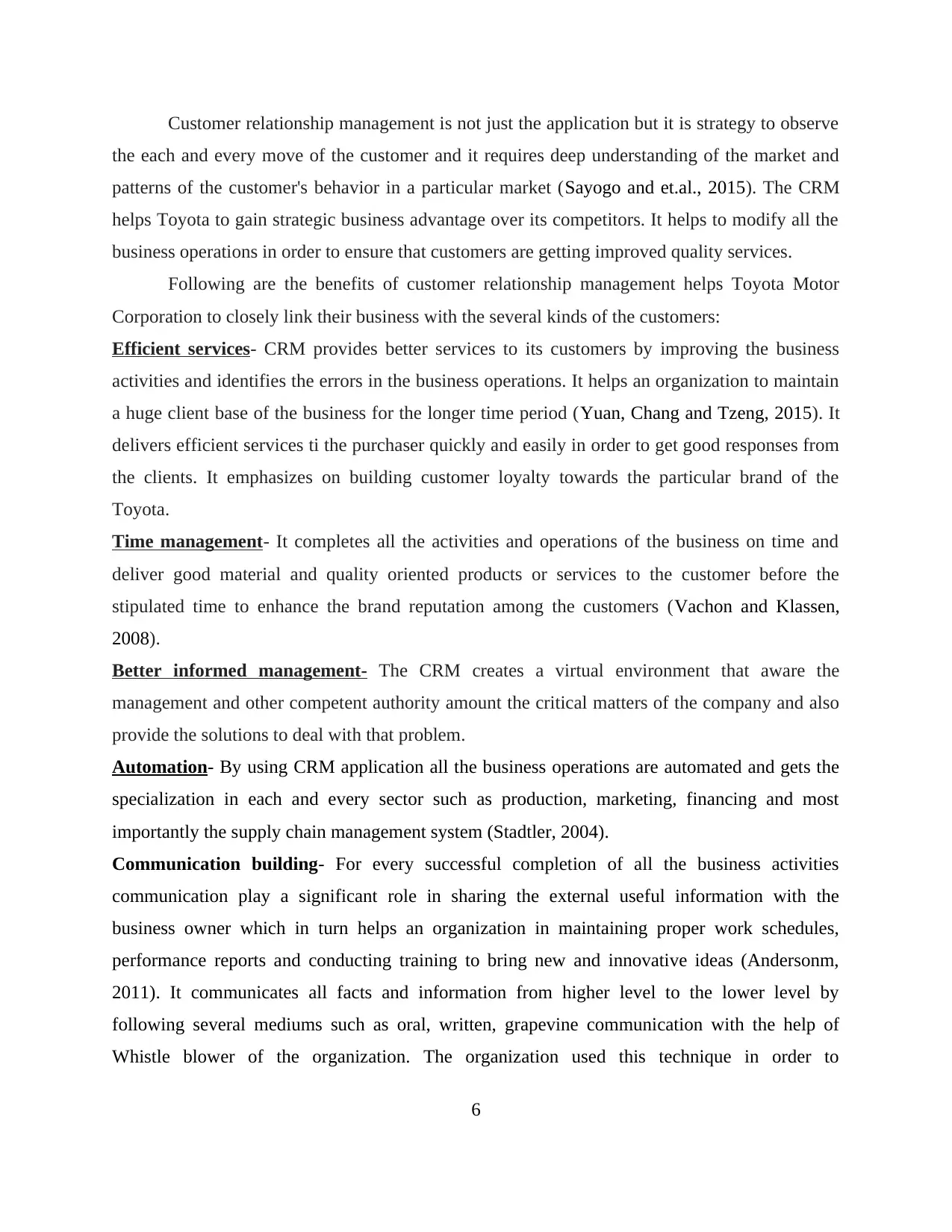
Customer relationship management is not just the application but it is strategy to observe
the each and every move of the customer and it requires deep understanding of the market and
patterns of the customer's behavior in a particular market (Sayogo and et.al., 2015). The CRM
helps Toyota to gain strategic business advantage over its competitors. It helps to modify all the
business operations in order to ensure that customers are getting improved quality services.
Following are the benefits of customer relationship management helps Toyota Motor
Corporation to closely link their business with the several kinds of the customers:
Efficient services- CRM provides better services to its customers by improving the business
activities and identifies the errors in the business operations. It helps an organization to maintain
a huge client base of the business for the longer time period (Yuan, Chang and Tzeng, 2015). It
delivers efficient services ti the purchaser quickly and easily in order to get good responses from
the clients. It emphasizes on building customer loyalty towards the particular brand of the
Toyota.
Time management- It completes all the activities and operations of the business on time and
deliver good material and quality oriented products or services to the customer before the
stipulated time to enhance the brand reputation among the customers (Vachon and Klassen,
2008).
Better informed management- The CRM creates a virtual environment that aware the
management and other competent authority amount the critical matters of the company and also
provide the solutions to deal with that problem.
Automation- By using CRM application all the business operations are automated and gets the
specialization in each and every sector such as production, marketing, financing and most
importantly the supply chain management system (Stadtler, 2004).
Communication building- For every successful completion of all the business activities
communication play a significant role in sharing the external useful information with the
business owner which in turn helps an organization in maintaining proper work schedules,
performance reports and conducting training to bring new and innovative ideas (Andersonm,
2011). It communicates all facts and information from higher level to the lower level by
following several mediums such as oral, written, grapevine communication with the help of
Whistle blower of the organization. The organization used this technique in order to
6
the each and every move of the customer and it requires deep understanding of the market and
patterns of the customer's behavior in a particular market (Sayogo and et.al., 2015). The CRM
helps Toyota to gain strategic business advantage over its competitors. It helps to modify all the
business operations in order to ensure that customers are getting improved quality services.
Following are the benefits of customer relationship management helps Toyota Motor
Corporation to closely link their business with the several kinds of the customers:
Efficient services- CRM provides better services to its customers by improving the business
activities and identifies the errors in the business operations. It helps an organization to maintain
a huge client base of the business for the longer time period (Yuan, Chang and Tzeng, 2015). It
delivers efficient services ti the purchaser quickly and easily in order to get good responses from
the clients. It emphasizes on building customer loyalty towards the particular brand of the
Toyota.
Time management- It completes all the activities and operations of the business on time and
deliver good material and quality oriented products or services to the customer before the
stipulated time to enhance the brand reputation among the customers (Vachon and Klassen,
2008).
Better informed management- The CRM creates a virtual environment that aware the
management and other competent authority amount the critical matters of the company and also
provide the solutions to deal with that problem.
Automation- By using CRM application all the business operations are automated and gets the
specialization in each and every sector such as production, marketing, financing and most
importantly the supply chain management system (Stadtler, 2004).
Communication building- For every successful completion of all the business activities
communication play a significant role in sharing the external useful information with the
business owner which in turn helps an organization in maintaining proper work schedules,
performance reports and conducting training to bring new and innovative ideas (Andersonm,
2011). It communicates all facts and information from higher level to the lower level by
following several mediums such as oral, written, grapevine communication with the help of
Whistle blower of the organization. The organization used this technique in order to
6
You're viewing a preview
Unlock full access by subscribing today!
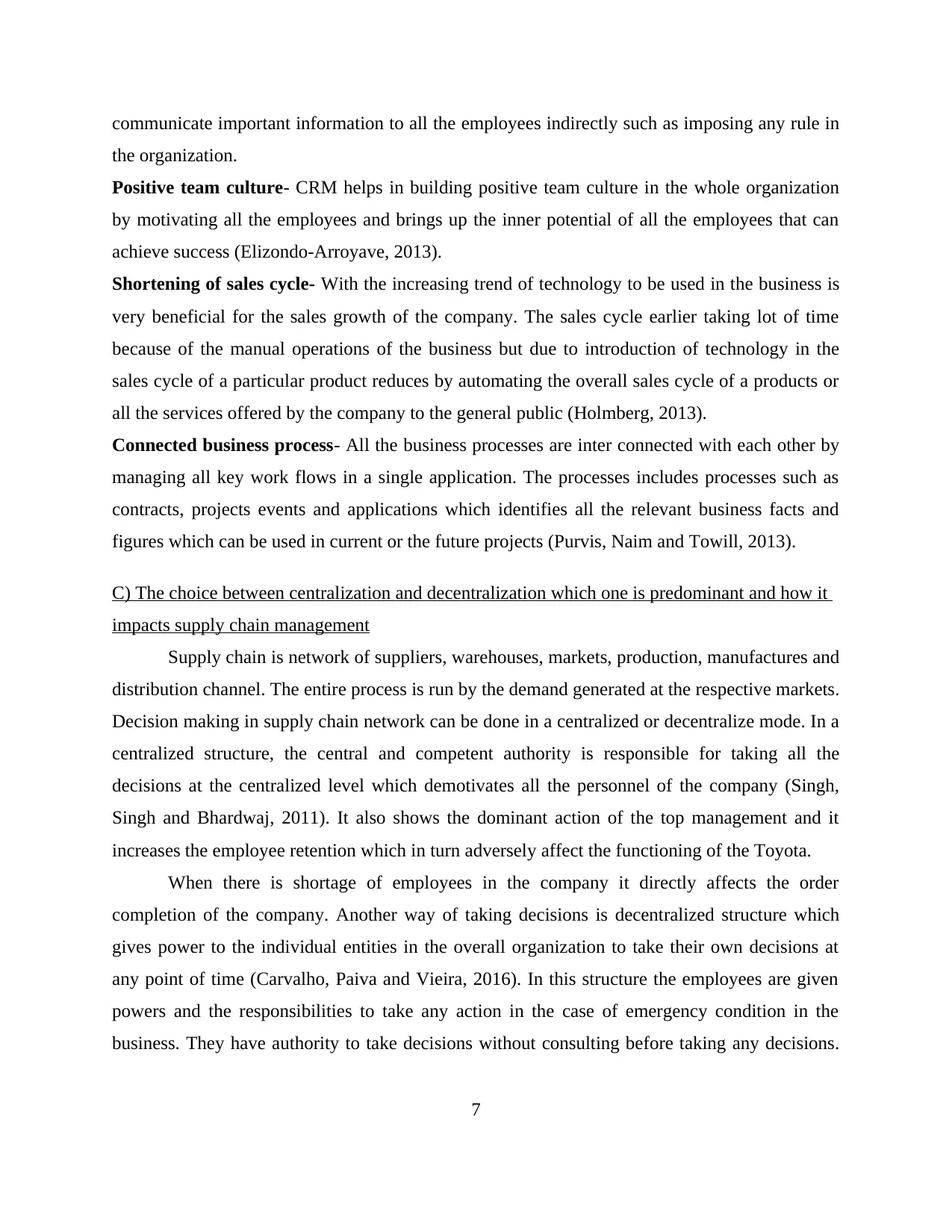
communicate important information to all the employees indirectly such as imposing any rule in
the organization.
Positive team culture- CRM helps in building positive team culture in the whole organization
by motivating all the employees and brings up the inner potential of all the employees that can
achieve success (Elizondo-Arroyave, 2013).
Shortening of sales cycle- With the increasing trend of technology to be used in the business is
very beneficial for the sales growth of the company. The sales cycle earlier taking lot of time
because of the manual operations of the business but due to introduction of technology in the
sales cycle of a particular product reduces by automating the overall sales cycle of a products or
all the services offered by the company to the general public (Holmberg, 2013).
Connected business process- All the business processes are inter connected with each other by
managing all key work flows in a single application. The processes includes processes such as
contracts, projects events and applications which identifies all the relevant business facts and
figures which can be used in current or the future projects (Purvis, Naim and Towill, 2013).
C) The choice between centralization and decentralization which one is predominant and how it
impacts supply chain management
Supply chain is network of suppliers, warehouses, markets, production, manufactures and
distribution channel. The entire process is run by the demand generated at the respective markets.
Decision making in supply chain network can be done in a centralized or decentralize mode. In a
centralized structure, the central and competent authority is responsible for taking all the
decisions at the centralized level which demotivates all the personnel of the company (Singh,
Singh and Bhardwaj, 2011). It also shows the dominant action of the top management and it
increases the employee retention which in turn adversely affect the functioning of the Toyota.
When there is shortage of employees in the company it directly affects the order
completion of the company. Another way of taking decisions is decentralized structure which
gives power to the individual entities in the overall organization to take their own decisions at
any point of time (Carvalho, Paiva and Vieira, 2016). In this structure the employees are given
powers and the responsibilities to take any action in the case of emergency condition in the
business. They have authority to take decisions without consulting before taking any decisions.
7
the organization.
Positive team culture- CRM helps in building positive team culture in the whole organization
by motivating all the employees and brings up the inner potential of all the employees that can
achieve success (Elizondo-Arroyave, 2013).
Shortening of sales cycle- With the increasing trend of technology to be used in the business is
very beneficial for the sales growth of the company. The sales cycle earlier taking lot of time
because of the manual operations of the business but due to introduction of technology in the
sales cycle of a particular product reduces by automating the overall sales cycle of a products or
all the services offered by the company to the general public (Holmberg, 2013).
Connected business process- All the business processes are inter connected with each other by
managing all key work flows in a single application. The processes includes processes such as
contracts, projects events and applications which identifies all the relevant business facts and
figures which can be used in current or the future projects (Purvis, Naim and Towill, 2013).
C) The choice between centralization and decentralization which one is predominant and how it
impacts supply chain management
Supply chain is network of suppliers, warehouses, markets, production, manufactures and
distribution channel. The entire process is run by the demand generated at the respective markets.
Decision making in supply chain network can be done in a centralized or decentralize mode. In a
centralized structure, the central and competent authority is responsible for taking all the
decisions at the centralized level which demotivates all the personnel of the company (Singh,
Singh and Bhardwaj, 2011). It also shows the dominant action of the top management and it
increases the employee retention which in turn adversely affect the functioning of the Toyota.
When there is shortage of employees in the company it directly affects the order
completion of the company. Another way of taking decisions is decentralized structure which
gives power to the individual entities in the overall organization to take their own decisions at
any point of time (Carvalho, Paiva and Vieira, 2016). In this structure the employees are given
powers and the responsibilities to take any action in the case of emergency condition in the
business. They have authority to take decisions without consulting before taking any decisions.
7
Paraphrase This Document
Need a fresh take? Get an instant paraphrase of this document with our AI Paraphraser
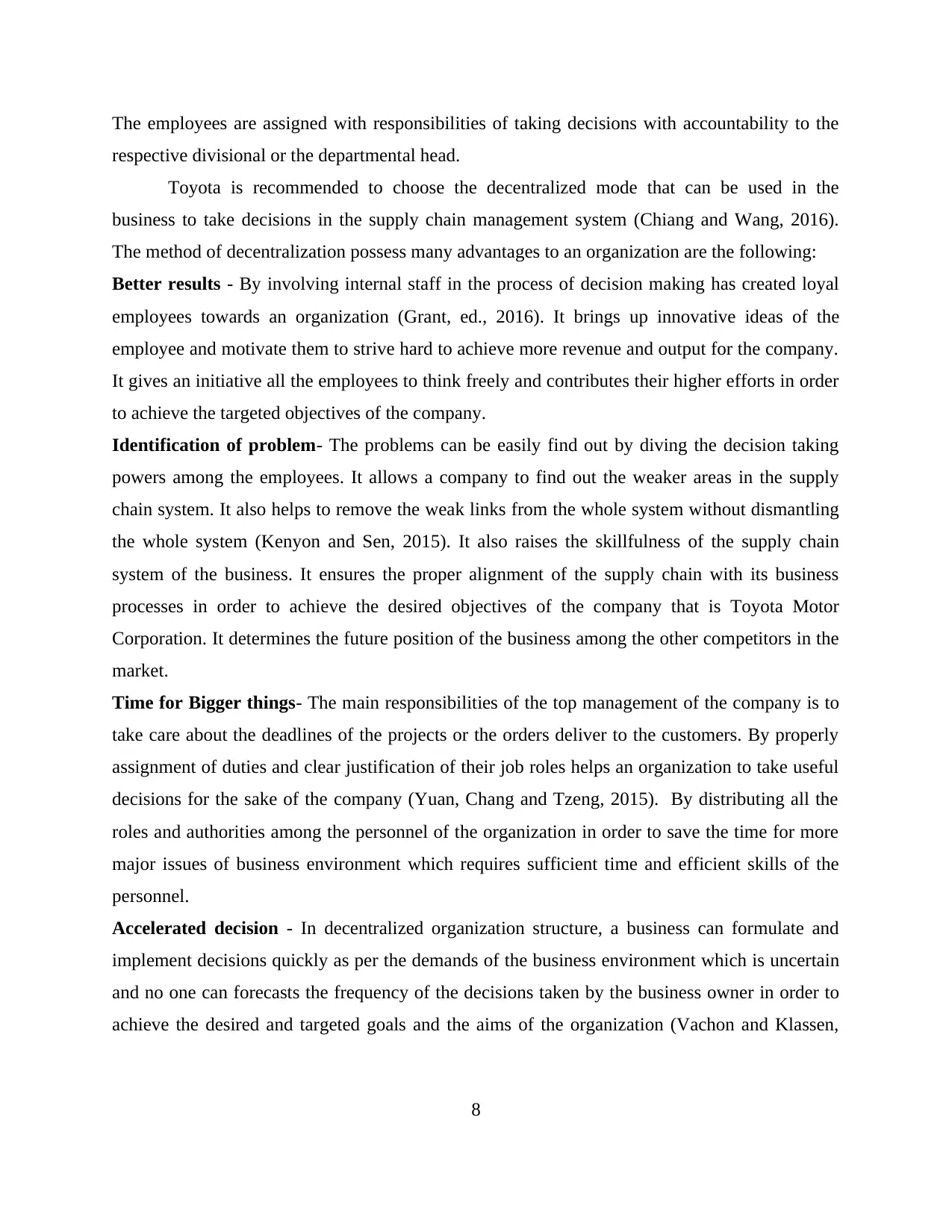
The employees are assigned with responsibilities of taking decisions with accountability to the
respective divisional or the departmental head.
Toyota is recommended to choose the decentralized mode that can be used in the
business to take decisions in the supply chain management system (Chiang and Wang, 2016).
The method of decentralization possess many advantages to an organization are the following:
Better results - By involving internal staff in the process of decision making has created loyal
employees towards an organization (Grant, ed., 2016). It brings up innovative ideas of the
employee and motivate them to strive hard to achieve more revenue and output for the company.
It gives an initiative all the employees to think freely and contributes their higher efforts in order
to achieve the targeted objectives of the company.
Identification of problem- The problems can be easily find out by diving the decision taking
powers among the employees. It allows a company to find out the weaker areas in the supply
chain system. It also helps to remove the weak links from the whole system without dismantling
the whole system (Kenyon and Sen, 2015). It also raises the skillfulness of the supply chain
system of the business. It ensures the proper alignment of the supply chain with its business
processes in order to achieve the desired objectives of the company that is Toyota Motor
Corporation. It determines the future position of the business among the other competitors in the
market.
Time for Bigger things- The main responsibilities of the top management of the company is to
take care about the deadlines of the projects or the orders deliver to the customers. By properly
assignment of duties and clear justification of their job roles helps an organization to take useful
decisions for the sake of the company (Yuan, Chang and Tzeng, 2015). By distributing all the
roles and authorities among the personnel of the organization in order to save the time for more
major issues of business environment which requires sufficient time and efficient skills of the
personnel.
Accelerated decision - In decentralized organization structure, a business can formulate and
implement decisions quickly as per the demands of the business environment which is uncertain
and no one can forecasts the frequency of the decisions taken by the business owner in order to
achieve the desired and targeted goals and the aims of the organization (Vachon and Klassen,
8
respective divisional or the departmental head.
Toyota is recommended to choose the decentralized mode that can be used in the
business to take decisions in the supply chain management system (Chiang and Wang, 2016).
The method of decentralization possess many advantages to an organization are the following:
Better results - By involving internal staff in the process of decision making has created loyal
employees towards an organization (Grant, ed., 2016). It brings up innovative ideas of the
employee and motivate them to strive hard to achieve more revenue and output for the company.
It gives an initiative all the employees to think freely and contributes their higher efforts in order
to achieve the targeted objectives of the company.
Identification of problem- The problems can be easily find out by diving the decision taking
powers among the employees. It allows a company to find out the weaker areas in the supply
chain system. It also helps to remove the weak links from the whole system without dismantling
the whole system (Kenyon and Sen, 2015). It also raises the skillfulness of the supply chain
system of the business. It ensures the proper alignment of the supply chain with its business
processes in order to achieve the desired objectives of the company that is Toyota Motor
Corporation. It determines the future position of the business among the other competitors in the
market.
Time for Bigger things- The main responsibilities of the top management of the company is to
take care about the deadlines of the projects or the orders deliver to the customers. By properly
assignment of duties and clear justification of their job roles helps an organization to take useful
decisions for the sake of the company (Yuan, Chang and Tzeng, 2015). By distributing all the
roles and authorities among the personnel of the organization in order to save the time for more
major issues of business environment which requires sufficient time and efficient skills of the
personnel.
Accelerated decision - In decentralized organization structure, a business can formulate and
implement decisions quickly as per the demands of the business environment which is uncertain
and no one can forecasts the frequency of the decisions taken by the business owner in order to
achieve the desired and targeted goals and the aims of the organization (Vachon and Klassen,
8
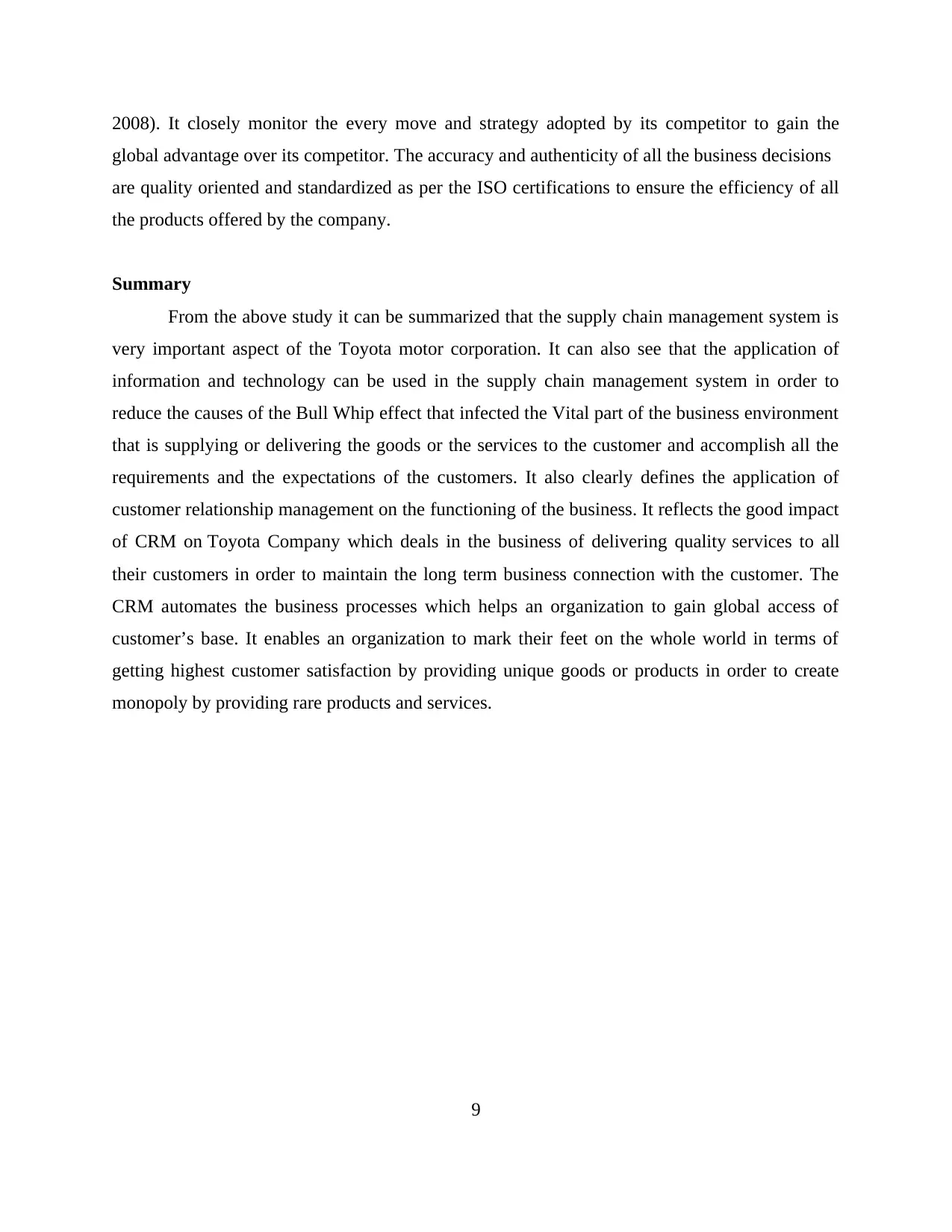
2008). It closely monitor the every move and strategy adopted by its competitor to gain the
global advantage over its competitor. The accuracy and authenticity of all the business decisions
are quality oriented and standardized as per the ISO certifications to ensure the efficiency of all
the products offered by the company.
Summary
From the above study it can be summarized that the supply chain management system is
very important aspect of the Toyota motor corporation. It can also see that the application of
information and technology can be used in the supply chain management system in order to
reduce the causes of the Bull Whip effect that infected the Vital part of the business environment
that is supplying or delivering the goods or the services to the customer and accomplish all the
requirements and the expectations of the customers. It also clearly defines the application of
customer relationship management on the functioning of the business. It reflects the good impact
of CRM on Toyota Company which deals in the business of delivering quality services to all
their customers in order to maintain the long term business connection with the customer. The
CRM automates the business processes which helps an organization to gain global access of
customer’s base. It enables an organization to mark their feet on the whole world in terms of
getting highest customer satisfaction by providing unique goods or products in order to create
monopoly by providing rare products and services.
9
global advantage over its competitor. The accuracy and authenticity of all the business decisions
are quality oriented and standardized as per the ISO certifications to ensure the efficiency of all
the products offered by the company.
Summary
From the above study it can be summarized that the supply chain management system is
very important aspect of the Toyota motor corporation. It can also see that the application of
information and technology can be used in the supply chain management system in order to
reduce the causes of the Bull Whip effect that infected the Vital part of the business environment
that is supplying or delivering the goods or the services to the customer and accomplish all the
requirements and the expectations of the customers. It also clearly defines the application of
customer relationship management on the functioning of the business. It reflects the good impact
of CRM on Toyota Company which deals in the business of delivering quality services to all
their customers in order to maintain the long term business connection with the customer. The
CRM automates the business processes which helps an organization to gain global access of
customer’s base. It enables an organization to mark their feet on the whole world in terms of
getting highest customer satisfaction by providing unique goods or products in order to create
monopoly by providing rare products and services.
9
You're viewing a preview
Unlock full access by subscribing today!
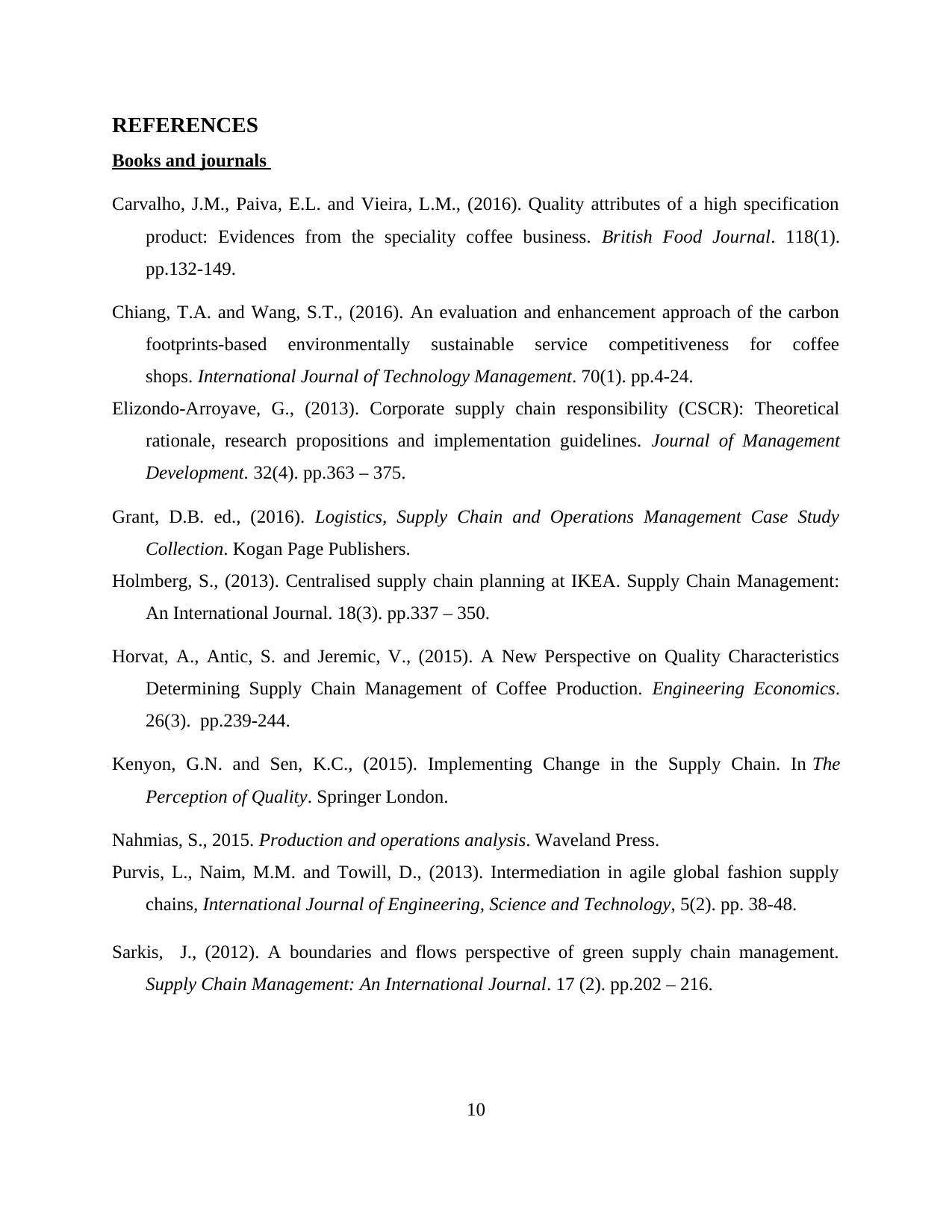
REFERENCES
Books and journals
Carvalho, J.M., Paiva, E.L. and Vieira, L.M., (2016). Quality attributes of a high specification
product: Evidences from the speciality coffee business. British Food Journal. 118(1).
pp.132-149.
Chiang, T.A. and Wang, S.T., (2016). An evaluation and enhancement approach of the carbon
footprints-based environmentally sustainable service competitiveness for coffee
shops. International Journal of Technology Management. 70(1). pp.4-24.
Elizondo-Arroyave, G., (2013). Corporate supply chain responsibility (CSCR): Theoretical
rationale, research propositions and implementation guidelines. Journal of Management
Development. 32(4). pp.363 – 375.
Grant, D.B. ed., (2016). Logistics, Supply Chain and Operations Management Case Study
Collection. Kogan Page Publishers.
Holmberg, S., (2013). Centralised supply chain planning at IKEA. Supply Chain Management:
An International Journal. 18(3). pp.337 – 350.
Horvat, A., Antic, S. and Jeremic, V., (2015). A New Perspective on Quality Characteristics
Determining Supply Chain Management of Coffee Production. Engineering Economics.
26(3). pp.239-244.
Kenyon, G.N. and Sen, K.C., (2015). Implementing Change in the Supply Chain. In The
Perception of Quality. Springer London.
Nahmias, S., 2015. Production and operations analysis. Waveland Press.
Purvis, L., Naim, M.M. and Towill, D., (2013). Intermediation in agile global fashion supply
chains, International Journal of Engineering, Science and Technology, 5(2). pp. 38-48.
Sarkis, J., (2012). A boundaries and flows perspective of green supply chain management.
Supply Chain Management: An International Journal. 17 (2). pp.202 – 216.
10
Books and journals
Carvalho, J.M., Paiva, E.L. and Vieira, L.M., (2016). Quality attributes of a high specification
product: Evidences from the speciality coffee business. British Food Journal. 118(1).
pp.132-149.
Chiang, T.A. and Wang, S.T., (2016). An evaluation and enhancement approach of the carbon
footprints-based environmentally sustainable service competitiveness for coffee
shops. International Journal of Technology Management. 70(1). pp.4-24.
Elizondo-Arroyave, G., (2013). Corporate supply chain responsibility (CSCR): Theoretical
rationale, research propositions and implementation guidelines. Journal of Management
Development. 32(4). pp.363 – 375.
Grant, D.B. ed., (2016). Logistics, Supply Chain and Operations Management Case Study
Collection. Kogan Page Publishers.
Holmberg, S., (2013). Centralised supply chain planning at IKEA. Supply Chain Management:
An International Journal. 18(3). pp.337 – 350.
Horvat, A., Antic, S. and Jeremic, V., (2015). A New Perspective on Quality Characteristics
Determining Supply Chain Management of Coffee Production. Engineering Economics.
26(3). pp.239-244.
Kenyon, G.N. and Sen, K.C., (2015). Implementing Change in the Supply Chain. In The
Perception of Quality. Springer London.
Nahmias, S., 2015. Production and operations analysis. Waveland Press.
Purvis, L., Naim, M.M. and Towill, D., (2013). Intermediation in agile global fashion supply
chains, International Journal of Engineering, Science and Technology, 5(2). pp. 38-48.
Sarkis, J., (2012). A boundaries and flows perspective of green supply chain management.
Supply Chain Management: An International Journal. 17 (2). pp.202 – 216.
10
Paraphrase This Document
Need a fresh take? Get an instant paraphrase of this document with our AI Paraphraser
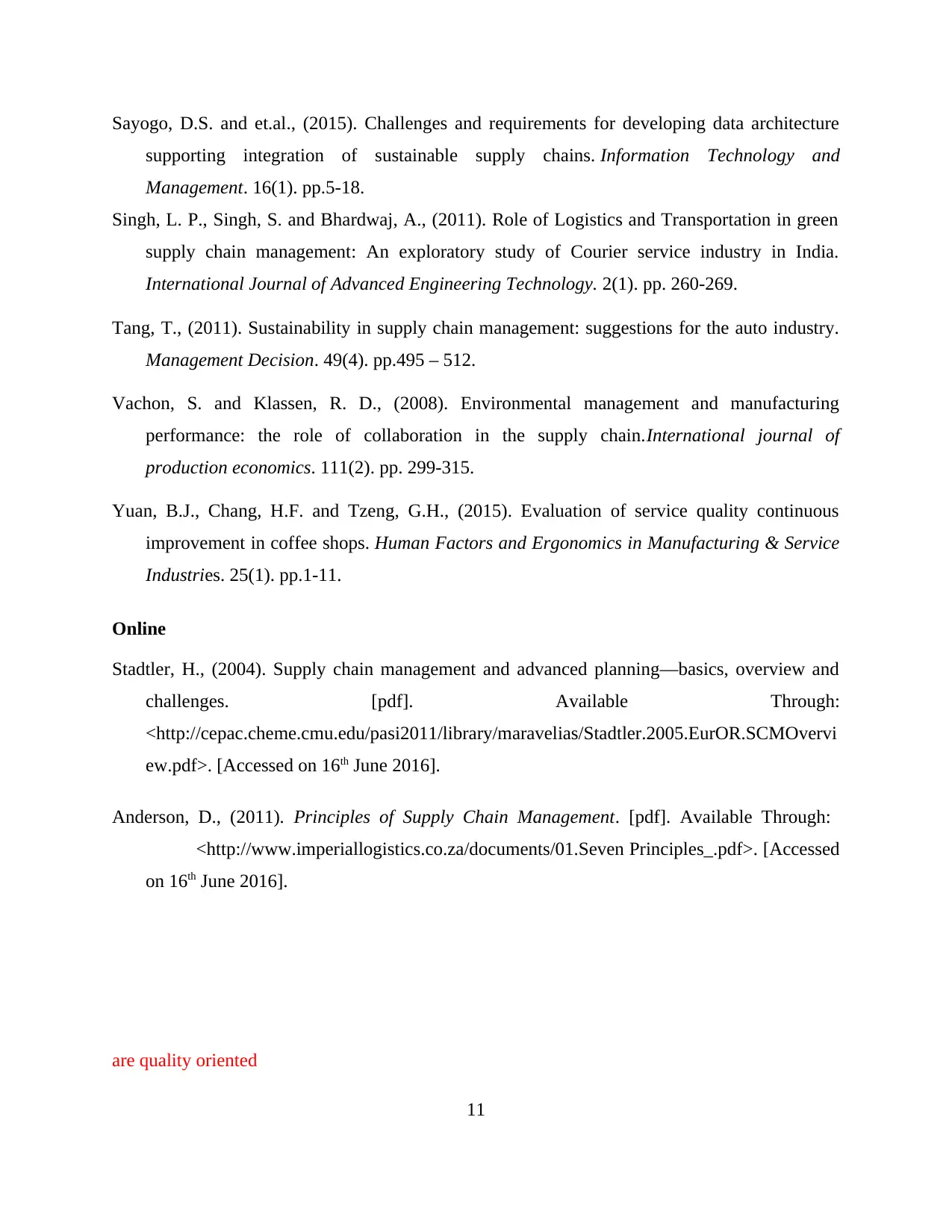
Sayogo, D.S. and et.al., (2015). Challenges and requirements for developing data architecture
supporting integration of sustainable supply chains. Information Technology and
Management. 16(1). pp.5-18.
Singh, L. P., Singh, S. and Bhardwaj, A., (2011). Role of Logistics and Transportation in green
supply chain management: An exploratory study of Courier service industry in India.
International Journal of Advanced Engineering Technology. 2(1). pp. 260-269.
Tang, T., (2011). Sustainability in supply chain management: suggestions for the auto industry.
Management Decision. 49(4). pp.495 – 512.
Vachon, S. and Klassen, R. D., (2008). Environmental management and manufacturing
performance: the role of collaboration in the supply chain.International journal of
production economics. 111(2). pp. 299-315.
Yuan, B.J., Chang, H.F. and Tzeng, G.H., (2015). Evaluation of service quality continuous
improvement in coffee shops. Human Factors and Ergonomics in Manufacturing & Service
Industries. 25(1). pp.1-11.
Online
Stadtler, H., (2004). Supply chain management and advanced planning––basics, overview and
challenges. [pdf]. Available Through:
<http://cepac.cheme.cmu.edu/pasi2011/library/maravelias/Stadtler.2005.EurOR.SCMOvervi
ew.pdf>. [Accessed on 16th June 2016].
Anderson, D., (2011). Principles of Supply Chain Management. [pdf]. Available Through:
<http://www.imperiallogistics.co.za/documents/01.Seven Principles_.pdf>. [Accessed
on 16th June 2016].
are quality oriented
11
supporting integration of sustainable supply chains. Information Technology and
Management. 16(1). pp.5-18.
Singh, L. P., Singh, S. and Bhardwaj, A., (2011). Role of Logistics and Transportation in green
supply chain management: An exploratory study of Courier service industry in India.
International Journal of Advanced Engineering Technology. 2(1). pp. 260-269.
Tang, T., (2011). Sustainability in supply chain management: suggestions for the auto industry.
Management Decision. 49(4). pp.495 – 512.
Vachon, S. and Klassen, R. D., (2008). Environmental management and manufacturing
performance: the role of collaboration in the supply chain.International journal of
production economics. 111(2). pp. 299-315.
Yuan, B.J., Chang, H.F. and Tzeng, G.H., (2015). Evaluation of service quality continuous
improvement in coffee shops. Human Factors and Ergonomics in Manufacturing & Service
Industries. 25(1). pp.1-11.
Online
Stadtler, H., (2004). Supply chain management and advanced planning––basics, overview and
challenges. [pdf]. Available Through:
<http://cepac.cheme.cmu.edu/pasi2011/library/maravelias/Stadtler.2005.EurOR.SCMOvervi
ew.pdf>. [Accessed on 16th June 2016].
Anderson, D., (2011). Principles of Supply Chain Management. [pdf]. Available Through:
<http://www.imperiallogistics.co.za/documents/01.Seven Principles_.pdf>. [Accessed
on 16th June 2016].
are quality oriented
11
1 out of 11
Related Documents
Your All-in-One AI-Powered Toolkit for Academic Success.
+13062052269
info@desklib.com
Available 24*7 on WhatsApp / Email
![[object Object]](/_next/static/media/star-bottom.7253800d.svg)
Unlock your academic potential
© 2024 | Zucol Services PVT LTD | All rights reserved.




